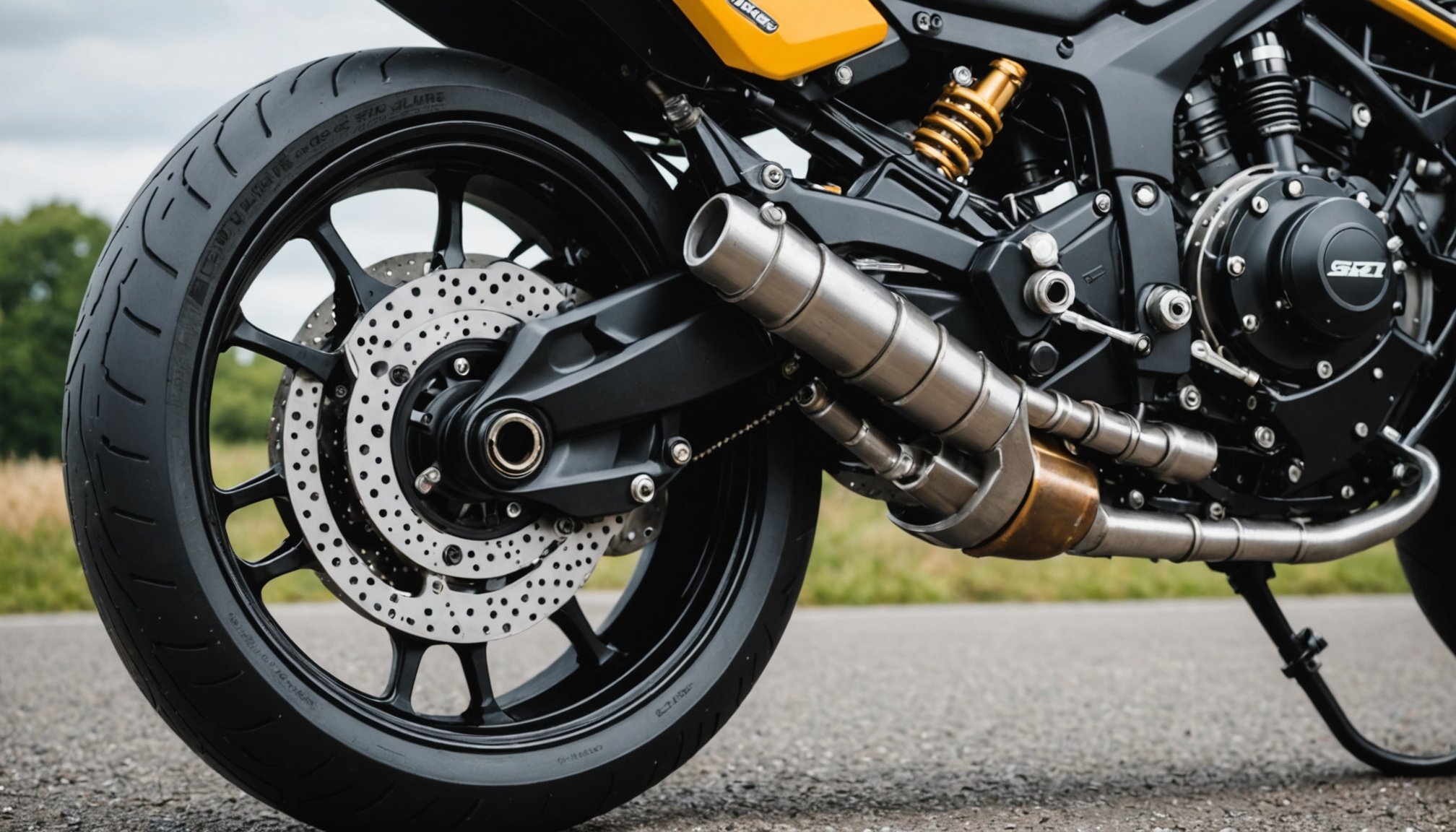Unlocking Superior Traction on UK’s Bumpy Roads: A Complete Guide to Optimizing Your Sport Bike’s Rear Suspension
Understanding the Importance of Rear Suspension
When it comes to riding a sport bike, especially on the often bumpy and unpredictable roads of the UK, having a well-optimized rear suspension is crucial. This component is not just about comfort; it’s about control, performance, and safety. Here’s why it’s so vital:
- Control and Stability: A properly set up rear suspension ensures that your bike maintains contact with the road, even on rough terrain. This stability is essential for cornering, braking, and accelerating.
- Performance: Good rear suspension can significantly enhance your bike’s handling and responsiveness. It allows you to push your bike harder and safer, whether you’re on a twisty mountain road or a straight highway.
- Comfort: While sport bikes are known for their aggressive riding positions, a well-tuned rear suspension can make a big difference in rider comfort, especially on long rides.
Choosing the Right Suspension Components
The first step in optimizing your sport bike’s rear suspension is selecting the right components. Here are some key factors to consider:
In parallel : Top Aftermarket Brake Levers for Sports Bikes: A Guide for UK Racing Enthusiasts
Frame and Swingarm
The frame and swingarm of your bike are the foundation of your rear suspension. A sturdy, well-designed frame and swingarm ensure that the suspension can function optimally. For example, the Triumph Daytona 660 features a robust tubular steel frame and a double-sided steel swingarm, providing a solid base for its suspension system[1].
Shock Absorber
The shock absorber is the heart of your rear suspension. Look for high-quality shock absorbers that offer multiple adjustments. The YSS shock absorbers, for instance, are known for their precision manufacturing and adjustable settings, making them an excellent choice for replacing OEM shocks[5].
Have you seen this : Top Security Chains for Safeguarding Sport Bikes in UK Cities: A Comprehensive Guide
Tyres
Tyres play a critical role in traction. Ensuring you have the right tyres for your riding conditions is essential. The Michelin Power 6 tyres on the Triumph Daytona 660, for example, offer reliable grip on both dry and wet roads[1].
Setting Up Your Rear Suspension
Setting up your rear suspension is an art that requires some understanding and patience. Here’s a step-by-step guide to help you get it right:
Preload Adjustment
Preload adjustment is crucial for setting the correct sag (the amount the suspension compresses under the weight of the bike and rider). Here’s how to do it:
- Measure the Sag: Measure the sag by placing a zip tie or a marker on the shock absorber and then sitting on the bike. The recommended sag is usually around 25-30 mm.
- Adjust the Preload: Use the preload adjuster to set the correct sag. This may involve adding or removing spacers or turning the adjuster.
Damping Adjustment
Damping controls how quickly the suspension compresses and rebounds. Here’s how to adjust it:
- Rebound Damping: Adjust the rebound damping to control how quickly the suspension returns to its original position after a bump. Too little rebound damping can make the bike feel bouncy, while too much can make it feel harsh.
- Compression Damping: Adjust the compression damping to control how quickly the suspension compresses. This setting is particularly important for high-speed bumps and corners.
Modes of Riding and Suspension Settings
Different riding modes require different suspension settings. Here’s a breakdown of how to adjust your suspension for various conditions:
Road Riding
For road riding, you typically want a firmer setup to maintain stability and control at higher speeds.
- Preload: Increase the preload to reduce sag and maintain a higher ride height.
- Damping: Increase the rebound and compression damping to control the suspension’s movement.
Wet or Gravel Roads
For wet or gravel roads, you need a softer setup to maintain traction.
- Preload: Reduce the preload to increase sag and lower the ride height.
- Damping: Reduce the rebound and compression damping to allow the suspension to move more freely.
Advanced Features and Technologies
Modern sport bikes often come with advanced features that can enhance your riding experience. Here are a few examples:
Electronic Suspension Adjustment
Some bikes, like the Triumph Daytona 660, come with electronic suspension adjustment systems. These systems allow you to quickly adjust the suspension settings using a handlebar-mounted control[1].
IMU and ABS
Bikes equipped with Inertial Measurement Units (IMU) and advanced ABS systems can optimize suspension and braking performance based on the bike’s angle of inclination and other parameters. The Trident 660, for example, uses IMU data to adjust the ABS and traction control settings in real-time[2].
Practical Tips and Anecdotes
Here are some practical tips and anecdotes to help you optimize your sport bike’s rear suspension:
Regular Maintenance
Regular maintenance is key to ensuring your suspension performs optimally. Here are some tips:
- Check the Sag Regularly: Regularly check the sag to ensure it remains within the recommended range.
- Clean and Lubricate: Clean and lubricate the suspension components regularly to prevent wear and tear.
Riding Techniques
Good riding techniques can also help you get the most out of your suspension. Here are a few tips:
- Smooth Inputs: Use smooth inputs on the throttle, brakes, and steering to avoid upsetting the suspension.
- Look Ahead: Always look ahead and anticipate bumps and corners to adjust your speed and position accordingly.
Comparison of Rear Suspension Systems
Here’s a comparison of the rear suspension systems of a few popular sport bikes:
| Bike Model | Rear Suspension | Adjustments | Tyres | Weight |
|---|---|---|---|---|
| Triumph Daytona 660 | Showa shock absorber with preload adjustment | Preload, rebound, compression | Michelin Power 6 | 201 kg[1] |
| Triumph Trident 660 | Showa shock absorber with SFF-BP technology and preload adjustment | Preload, rebound, compression | Michelin Road 5 | 199 kg[2] |
| Ducati Panigale V4 | Öhlins TTX36 shock absorber with full adjustment | Preload, rebound, compression | Pirelli Diablo Supercorsa SP | 198 kg[4] |
| Kawasaki Ninja 1000SX | Horizontal back-link with gas-charged shock absorber and preload adjustment | Preload, rebound, compression | Bridgestone Battlax Hypersport S22 | 226 kg[4] |
Quotes from Experts and Riders
Here are some quotes from experts and riders that highlight the importance of rear suspension:
- “A well-set-up rear suspension can make a huge difference in how your bike handles. It’s not just about comfort; it’s about control and performance.” – A Triumph engineer, discussing the importance of suspension tuning.
- “I was amazed at how much better my bike handled after I adjusted the rear suspension. It was like riding a different bike.” – A rider who recently optimized their sport bike’s rear suspension.
Optimizing your sport bike’s rear suspension is a process that requires patience, understanding, and practice. By choosing the right components, setting up your suspension correctly, and using advanced features and technologies, you can significantly enhance your bike’s performance and your riding experience. Remember, it’s all about finding the right balance between comfort, control, and performance.
Whether you’re riding on the bumpy roads of the UK or any other challenging terrain, a well-optimized rear suspension will give you the confidence and control you need to ride at your best. So, take the time to understand and adjust your rear suspension – your bike, and your riding experience, will thank you.










